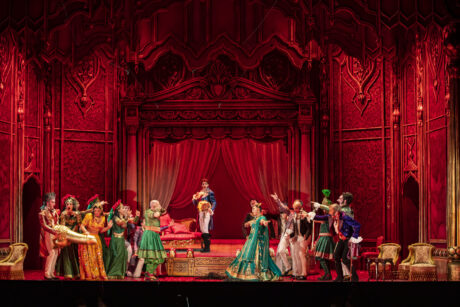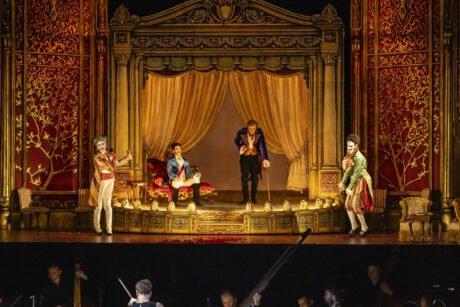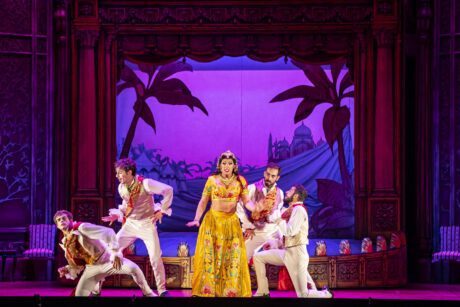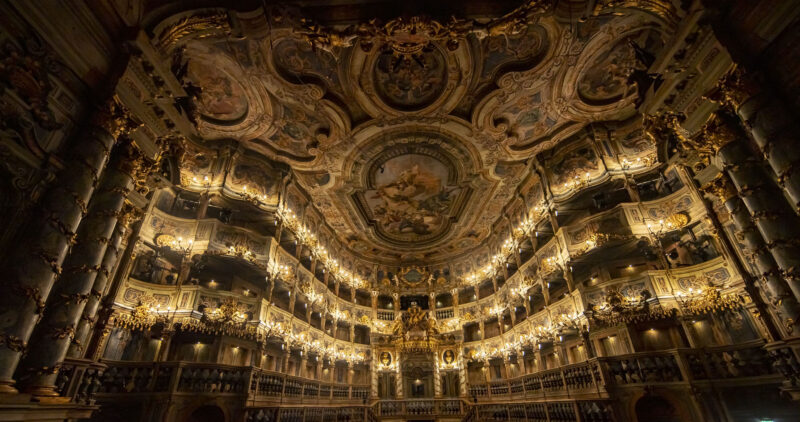
Bayreuth, Germany, an epicenter of creativity and exploration in the world of opera, hosted its third Baroque Opera Festival (BBOF) this year with a lively program of works including Allesandro Nell’Indie, which was lit by French LD David Debrinay using over 50 Robe moving lights including T1 and T2 Profiles and LEDBeam 350s.
Three memorable performances directed by Max Emmanuel Cencic, also artistic director of the Festival and one of the principals, were staged at the stunning Margravial Opera House (Markgräfliches Opernhaus). Opened in 1748 and declared a UNESCO World Heritage site in 2012, the venue reopened in 2018 after extensive renovations. It is also a museum and is licensed for just 30 live performances per year.
 Debrinay, from the Lyon-based design practice LJOMA Studio, and Cencic have worked on several previous projects including the two other Bayreuth Baroque Opera Festivals in 2020 and 2021. They share a great imaginative synergy which is essential in a scenario like this, where the lighting of a new opera production has to happen in a five- or six-day period, a super-quick and highly pressured timeframe more often associated with rock ‘n’ roll.
Debrinay, from the Lyon-based design practice LJOMA Studio, and Cencic have worked on several previous projects including the two other Bayreuth Baroque Opera Festivals in 2020 and 2021. They share a great imaginative synergy which is essential in a scenario like this, where the lighting of a new opera production has to happen in a five- or six-day period, a super-quick and highly pressured timeframe more often associated with rock ‘n’ roll.
Multiple creative starting points for Debrinay’s lighting design included Max’s overall direction of the piece together with Dominico Franchi’s intricate set with its rolling B-stage, and Guiseppe Palella’s elaborate costumes, of all of which brought an air of Bollywood glamour, color, humor, and fantasy to the stage as the libretto unfolded. The five-hour performance was set around Alexander the Great’s Indian campaign and his defeat of King Poros in 326 BCE at the Battle of Hydaspes.
Co-ordinating the Festival’s lighting specification and procurement was Kai Fischer who is based locally and works as a freelance and technical production specialist and manager for a range of shows and events. He’s worked on the Bayreuth Baroque Opera festival since its inception for event production company TC Promotion which co-ordinates all the Festival’s production requirements and has also worked on a couple of Bayreuth Wagner Festival seasons, so he knows the city and the venue well.
 As the Margravial Opera House can only present 30 live shows a year, there is no house lighting system, and all production must be outsourced. Fischer studied the lighting plot, discussed it at length with Debrinay, and then found the best kit to deliver his optimal show lighting. In 2021, there had been some color mixing issues with the chosen moving lights, so this year a priority was to change the brand and to ensure that everything would be perfect to unlock Debrinay’s visual flair for enriching the action.
As the Margravial Opera House can only present 30 live shows a year, there is no house lighting system, and all production must be outsourced. Fischer studied the lighting plot, discussed it at length with Debrinay, and then found the best kit to deliver his optimal show lighting. In 2021, there had been some color mixing issues with the chosen moving lights, so this year a priority was to change the brand and to ensure that everything would be perfect to unlock Debrinay’s visual flair for enriching the action.
One of Debrinay’s stipulations was for color changing followspots, which became a driver as Fischer looked for flexible LED followspotting solutions, and this brought him first to the RoboSpot remote followspot system. Only LED fixtures can be used in the Margravial Opera House auditorium – to reduce heat and preserve the precious historic décor and environment as well as for sustainability – so he sought bright and powerful LED units that would work as followspots.
Robe Germany’s Michael Herrmann recommended he look at a RoboSpot system coupled with T2 Profiles. They were certainly bright enough and have other aesthetic advantages – like high CRI – making them ideal for followspotting in this type of environment. As using a RoboSpot system removed the need for operators standing in the tiny FOH spotlight cabin, this also eliminated any potential disruption with show calling and stage management cues being audible over the intercom – a source of intense irritation to notoriously unforgiving opera audiences!

So having two T2 Profiles running on the two RoboSpot systems controlled from a booth backstage was an ingenious solution. They could change color and, furthermore, when not in use as followspots, the fixtures could be utilized for other roles in the show. The silent running of the T2 Profile also addressed another challenge! Two other key FOH positions are just 30 cm away from the nearest audience members sitting literally next to the fixtures at the edges of the third balcony. Due to the building’s design and heritage status no advanced truss can be flown.
Impressed with all the T2 Profile features, Debrinay and Fischer specified another 20 units onto the production which were distributed on the over-stage LX bars 1, 3, 4, and 6, making up the total of 24 T2 Profiles. These were augmented with 12 T1 Profiles and 24 LEDBeam 350s. Four T1s, one each on two towers each side of the stage, were joined by six on LX2 with the last pair in the very tight stage ‘slip’ positions on the floor.
In the acute angled auditorium slip positions offstage right and left was one LEDBeam 350 a side for very steep front washes, with the rest distributed on over-stage LX bars 1, 3, 4 and 5 where they worked as general stage washing and for specials. TC Promotion had purchased eight of their own LEDBeam 350s over the summer, and these were boosted with another 16, supplied, together with all the other Robe kit, by rental company Motion Group.

“Everyone was delighted with the choice of lights,” enthused Fischer including the DoP from TV production company Ozango who streamed the Allesandro Nell’Indie performances for broadcaster Arte.
The FOH T2 Profile followspots running at just 20% were sufficient for capturing the essence and style of the production and making it look great live and on camera. The Festival RoboSpot operators were also impressed. It was Stefan Schmidt’s first RoboSpot adventure, so he did some homework beforehand at Munich Volkstheater which also has a system and found it very straightforward to learn. Peter Schaarschuh has used it before on The Voice of Germany, and was happy to do so again here, appreciating the adaptability and being able to keep up with fast moving performers.
Before the final lighting spec was confirmed, Herrmann from Robe Germany and Fischer conducted extensive testing at the venue to ensure all the fixtures would work as envisioned. When contemplating lighting the show, Debrinay had two fundamentals in mind. He knew the costumes would be colorful, bright, and somewhat bling-tastic, with lots of diamonds and crystals, so good quality front and white light was crucial to making all this detail pop for the audience.
Colors were also an absolute key to energizing the vitality, look and style that everyone wanted for this production. Debrinay needed tight and precise color control for authentic flesh tones and dealing properly with the stage makeup. As the set floor and walls were dark red, he also needed to shift those major surface colors dynamically – glowing with electric reds and blues, bouncing yellows and zesty greens – over the duration of the performance, in the process adding depth to all the scenic pieces, so saturated colors were essential as well as having efficient wash light for adding smooth tints and accurate detailing. Many asks for one fixture.
He noted that using a ‘conventional’ followspot, he would typically expect to get about 4 or 5 tints from the luminaire. Using the T2 Profiles in this role, he could get around 15 or 16 or more tints from the fixtures, and these could even shift within a cue, so was extremely satisfied with this and how the refined light output worked in relation to the faces and costumes.
He describes the quality of the T2’s multi spectral light engine as “amazing” especially when layering the tinting and the CT whites delivered through additive color mixing, while maintaining the strength and brightness of saturated colors. Spreading the emitted light equally throughout the Planck curve, the T2 provides the widest possible color gamut, while simultaneously delivering full seamless CCT range control. It was also his first time using T1 Profiles although it “definitely won’t be the last,” and he was very satisfied with the compact LEDBeam 350s and their saturated colors.
Working in this incredibly special space was a huge privilege and responsibility for all involved, and Debrinay and Fischer started from scratch on the lighting to make Alessandro Nell’Indie into a truly magical performance. It was a great collaborative experience working with a team of talented and passionate individuals all dedicated to realizing this new production of the work and making it come alive in such a unique setting. Lighting was programmed by Matthias Schäflein onto an ETC ION Xe console – the two have worked together since the first BBOF.
Further information from Robe lighting: www.robe.cz
Photos: By Louise Stickland


